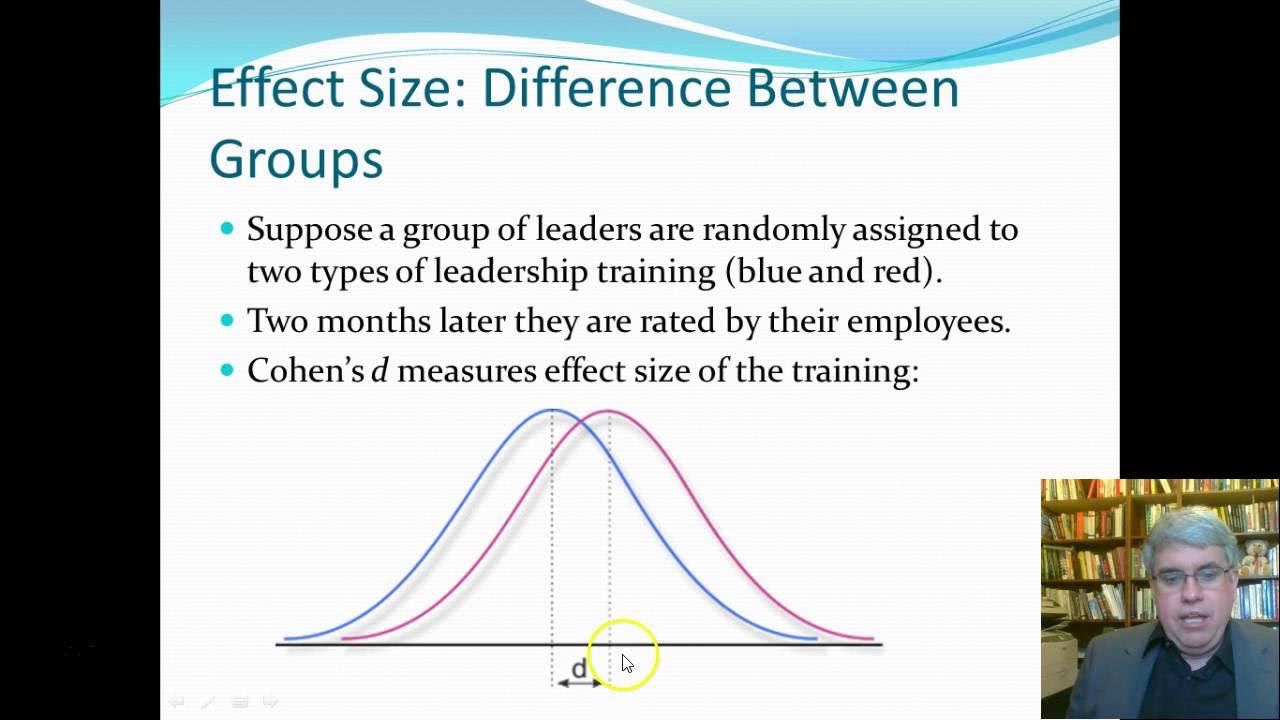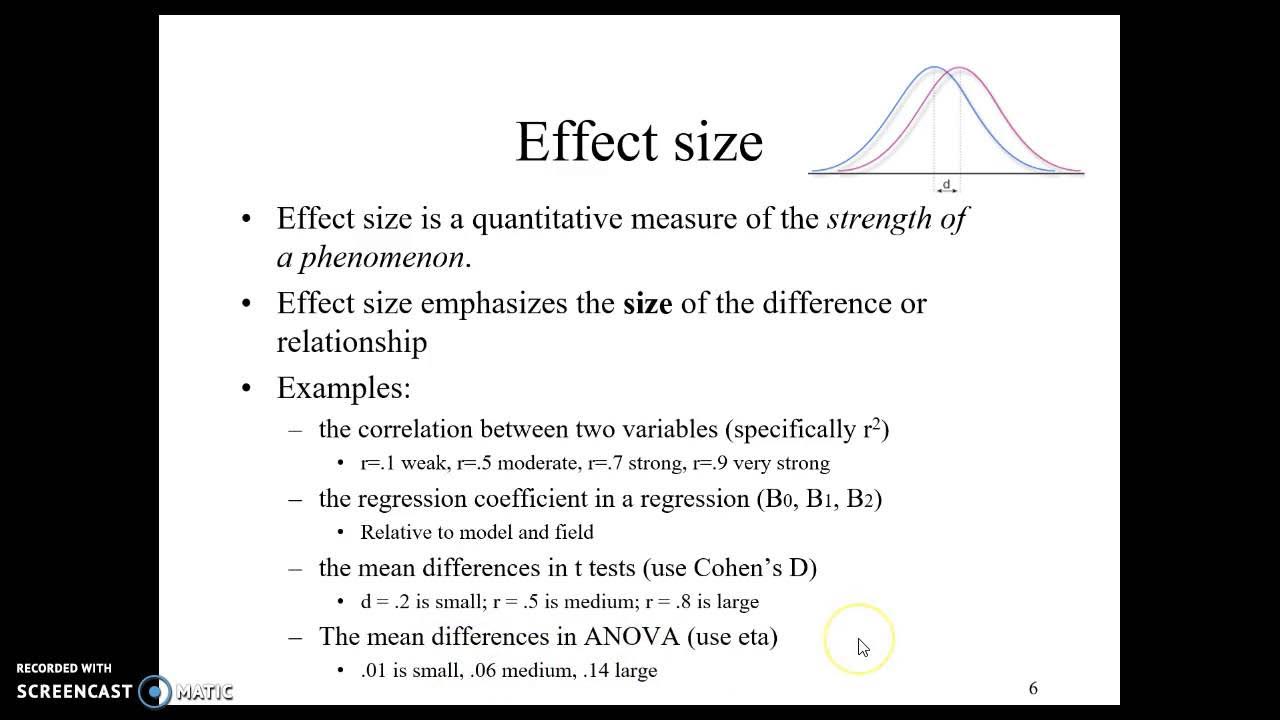How to find Cohen's D to determine the Effect Size Using Pooled Standard Deviation
TLDRThis video explains how to calculate Cohen's d to determine the effect size between two sample means. It provides the formula for Cohen's d: the difference between the two sample means divided by the pooled standard deviation. It also gives formulas for calculating the pooled standard deviation. A d value near 0.2 indicates a small effect size, 0.5 a medium effect, and 0.8 or higher a large effect size. The video then works through two examples, calculating Cohen's d and the pooled standard deviation for test scores from two classes and weights from two groups of people. It determines whether the effect sizes are small, medium or large based on the d values.
Takeaways
- 😀 Cohen's d tells us how many standard deviations separate two group means
- 😊 A d value of 0.2 is a small effect size, 0.5 is medium, and 0.8+ is large
- 📝 The formula is difference in group means divided by pooled standard deviation
- 📊 Use one formula to calculate pooled SD if sample sizes are very different
- 🖥️ Use a simpler formula if sample sizes are equal or very close
- 💡 Calculate pooled SD first before calculating Cohen's d
- 🔢 Plug sample sizes, means, and SDs into formula to get pooled SD
- 📈 Then use group means and pooled SD to calculate Cohen's d
- 🤔 Compare the d value to thresholds to evaluate effect size
- ✅ Use Cohen's d to quantify and describe differences between groups
Q & A
What is Cohen's d?
-Cohen's d is a measure used in statistics to indicate the size of an effect or the difference between two sample means in terms of standard deviation units.
What does a Cohen's d value of 1 indicate?
-A Cohen's d value of 1 indicates that the difference between the two sample means is equal to one standard deviation.
How is the size of the effect categorized using Cohen's d values?
-The size of the effect is categorized as small if Cohen's d is around 0.2, medium if it's around 0.5, and large if it's 0.8 or more.
What formula is used to calculate Cohen's d?
-To calculate Cohen's d, the formula used is the difference between the two sample means divided by the pooled standard deviation.
How do you calculate the pooled standard deviation?
-The pooled standard deviation is calculated using the formula: [(n1-1) * s1^2 + (n2-1) * s2^2] / (n1 + n2 - 2), where n1 and n2 are the sample sizes, and s1 and s2 are the standard deviations of the two samples.
What alternative formula can be used for calculating the pooled standard deviation when sample sizes are equal?
-When sample sizes are equal, the simpler formula for pooled standard deviation is the square root of [(s1^2 + s2^2) / 2].
What does a Cohen's d value of 0.8485 indicate about the size of the effect?
-A Cohen's d value of 0.8485 indicates that the size of the effect is large.
Why might the pooled standard deviation be closer to one group's standard deviation in cases of unequal sample sizes?
-In cases of unequal sample sizes, the pooled standard deviation might be closer to the standard deviation of the group with the larger sample size because it carries more weight in the calculation.
What does a Cohen's d value of approximately 0.559 indicate about the size of the effect in the second example?
-A Cohen's d value of approximately 0.559 indicates that the size of the effect is medium in the second example.
How can the absolute value be used in calculating Cohen's d?
-The absolute value is used in calculating Cohen's d to ensure a positive result, indicating the magnitude of the difference between two means regardless of direction.
Outlines
😀 How to calculate Cohen's d to determine effect size
This paragraph explains what Cohen's d represents, with a d value of 1 meaning the difference between two sample means equals 1 standard deviation. It states guidelines on interpreting effect size based on d value (0.2 is small, 0.5 is medium, 0.8+ is large). The formula to calculate Cohen's d is provided.
😊 Calculating Cohen's d for test score example
This paragraph works through an example problem calculating Cohen's d for test scores of two classes. It calculates the pooled standard deviation using the full formula and a shortcut formula (since sample sizes are equal). It plugs the values into the Cohen's d formula to calculate a d of 0.8485, meaning a large effect size.
😃 Cohen's d example for average weights
This paragraph provides another Cohen's d example using average weights for two groups. It calculates the pooled standard deviation using the full formula due to unequal sample sizes. It determines a Cohen's d of 0.559, indicating a medium effect size based on the weight means.
Mindmap
Keywords
💡Cohen's d
💡effect size
💡standard deviation
💡pooled standard deviation
💡difference in means
💡sample size
💡test scores
💡weight
💡effect interpretation
💡statistical significance
Highlights
First significant highlight text
Second notable highlight text
Third innovative method introduced
Fourth theoretical contribution discussed
Fifth notable impact highlighted
Sixth practical application explained
Seventh key finding elaborated
Eighth unique approach unveiled
Ninth critical challenge addressed
Tenth solution proposed
Eleventh future research direction suggested
Twelfth collaboration opportunity mentioned
Thirteenth technological advancement discussed
Fourteenth case study analyzed
Fifteenth policy implication considered
Transcripts
5.0 / 5 (0 votes)
Thanks for rating:





